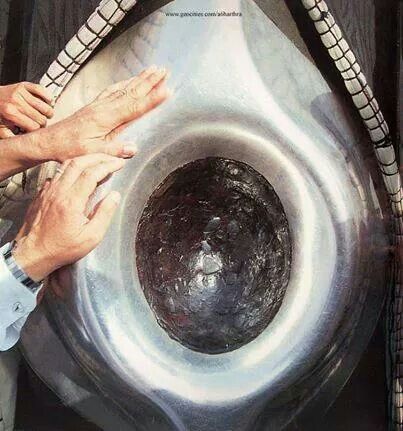COMMENTARIES ON ISLAM
The Black Stone
The Black Stone of Mecca, or al-ḥajr al-aswad, a sacred stone that is possibly a piece of meteorite, is fixed into the wall in the eastern corner of the Kaaba. It measures about 12 inches in diameter. When pilgrims walk around the Kaaba, they often try to touch or kiss the stone. Worn down by centuries of contact, the stone’s cracked and broken pieces are now held together by a wide silver band. Tradition says that Adam received the stone when he and Eve were expelled from paradise so he could obtain forgiveness of his sins. Muslims believe that Abraham and Ismail later placed the stone in the Kaaba when they rebuilt it. The stone is a symbol of Allah’s covenant with Abraham and Ismail and with the Muslim community itself. According to tradition, the stone was originally white but turned black after absorbing the sins of the many pilgrims who have touched it.
The Black Stone consists of three pieces and several fragments put together in a ring of stone and mounted in a silver band. It is placed on the eastern corner of the Kaʿbah, the cubically shaped sanctuary in the center of the Grand Masjid al-Ḥarām in Mecca; it is the focus of the annual pilgrimage and the direction of Muslims’ daily prayers. It stands around five feet above the ground; its diameter is approximately twelve inches. Although several writers have attributed extraordinary qualities to the Black Stone, ʿUmār ibn al-Khaṭṭāb, the second caliph, is reported to have touched the stone with a stick and said, “You are no more than a stone; if the Prophet had not kissed you I would have thrown you out of the Kaʿbaḥ.” This indicates that for the first community of the believers the stone carried no extraordinary quality.
Nevertheless, the Black Stone has special significance. According to tradition, it came with Adam; thus, tradition holds Adam to be the original builder of the Kaʿbah. Tradition also mentions that due to a fire in the Kaʿbah, the stone was broken into pieces and when ʿAbd Allāh ibn Zubayr reconstructed the Kaʿbah, he joined the pieces together with silver wires. The ʿAbbāsid caliph Hārūn al-Rashīd (d. 809 AD) replaced the wire with a silver band. The basic function of the stone is to indicate the starting point of the ṭawāf, the circumambulation of the Kaʿbah, a ritual of the pilgrimage. While facing the stone a person raises his or her hands toward the stone, basking in Allah’s greatness and glory. Those who kiss it or touch with their hand do so simply to follow the reported practice of Prophet Muḥammad.

The Black Stone is seen through a portal in the Kaaba.
The Black Stone consists of three pieces and several fragments put together in a ring of stone and mounted in a silver band. It is placed on the eastern corner of the Kaʿbah, the cubically shaped sanctuary in the center of the Grand Masjid al-Ḥarām in Mecca; it is the focus of the annual pilgrimage and the direction of Muslims’ daily prayers. It stands around five feet above the ground; its diameter is approximately twelve inches. Although several writers have attributed extraordinary qualities to the Black Stone, ʿUmār ibn al-Khaṭṭāb, the second caliph, is reported to have touched the stone with a stick and said, “You are no more than a stone; if the Prophet had not kissed you I would have thrown you out of the Kaʿbaḥ.” This indicates that for the first community of the believers the stone carried no extraordinary quality.
Nevertheless, the Black Stone has special significance. According to tradition, it came with Adam; thus, tradition holds Adam to be the original builder of the Kaʿbah. Tradition also mentions that due to a fire in the Kaʿbah, the stone was broken into pieces and when ʿAbd Allāh ibn Zubayr reconstructed the Kaʿbah, he joined the pieces together with silver wires. The ʿAbbāsid caliph Hārūn al-Rashīd (d. 809 AD) replaced the wire with a silver band. The basic function of the stone is to indicate the starting point of the ṭawāf, the circumambulation of the Kaʿbah, a ritual of the pilgrimage. While facing the stone a person raises his or her hands toward the stone, basking in Allah’s greatness and glory. Those who kiss it or touch with their hand do so simply to follow the reported practice of Prophet Muḥammad.
The stone was venerated at the Kaaba in pre-Islamic pagan times. According to Islamic tradition, it was set intact into the Kaaba’s wall by the Islamic prophet Muhammad in 605 CE, five years before his first revelation. Since then it has been broken into fragments and is now cemented into a silver frame in the side of the Kaaba. Its physical appearance is that of a fragmented dark rock, polished smooth by the hands of pilgrims. Islamic tradition holds that it fell from heaven as a guide for Adam and Eve to build an altar. It has often been described as a meteorite.
Muslim pilgrims circle the Kaaba as a part of the Tawaf ritual during the hajj and many try to stop to kiss the Black Stone, emulating the kiss that Islamic tradition records that it received from Muhammad. Muslims do not worship the Black Stone.
Scientific analysis of the Wabar site suggests that the impact event happened much more recently than first thought and might have occurred within the last 200–300 years. The meteoritic hypothesis is viewed by geologists as doubtful. The British Natural History Museum suggests that it may be a pseudo-meteorite, in other words a terrestrial rock mistakenly attributed to a meteoritic origin. The Black Stone has never been analyzed with modern scientific techniques and its origins remain the subject of speculation.
The Black Stone
115 – 002
https://discerning-Islam.org
Last Update: 02/2021
See COPYRIGHT information below.



